Leadership and Management Essay: Theories and Care UK Analysis
VerifiedAdded on 2023/01/12
|16
|5353
|87
Report
AI Summary
This report is a comprehensive literature review and essay on leadership and management, focusing on various theories and their practical applications. The essay begins with an introduction to the concepts of leadership and management, emphasizing their similarities and differences. It then delves into specific leadership theories, including contingency and transformational leadership, providing detailed explanations and examples. The report uses Care UK as a case study to illustrate the application of these theories in a real-world business context, analyzing the effectiveness of different leadership styles. Furthermore, the essay evaluates a leadership development program, highlighting its importance and benefits for both the organization and its individual members. The report concludes with a summary of the key findings and insights gained from the analysis.
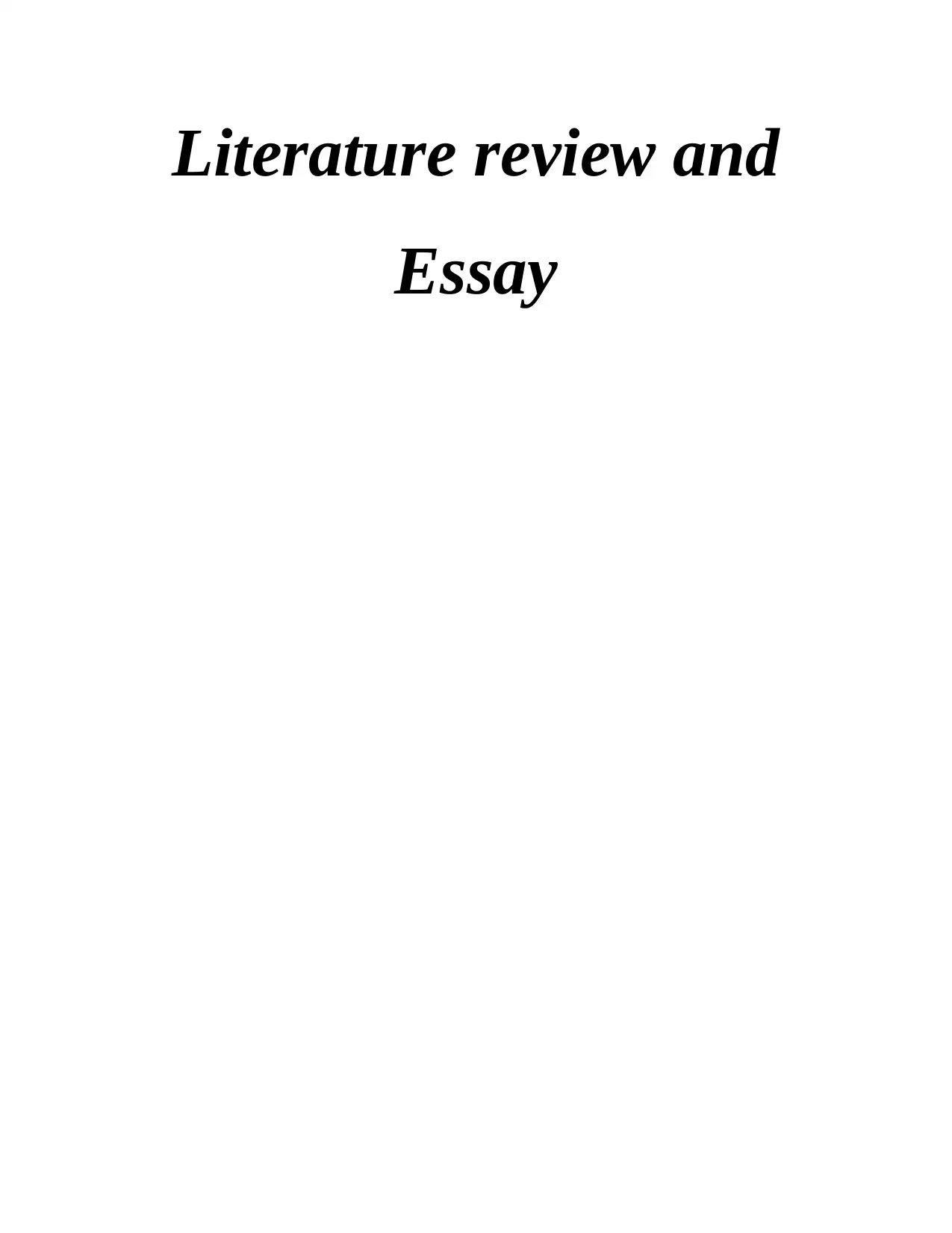
Literature review and
Essay
Essay
Paraphrase This Document
Need a fresh take? Get an instant paraphrase of this document with our AI Paraphraser
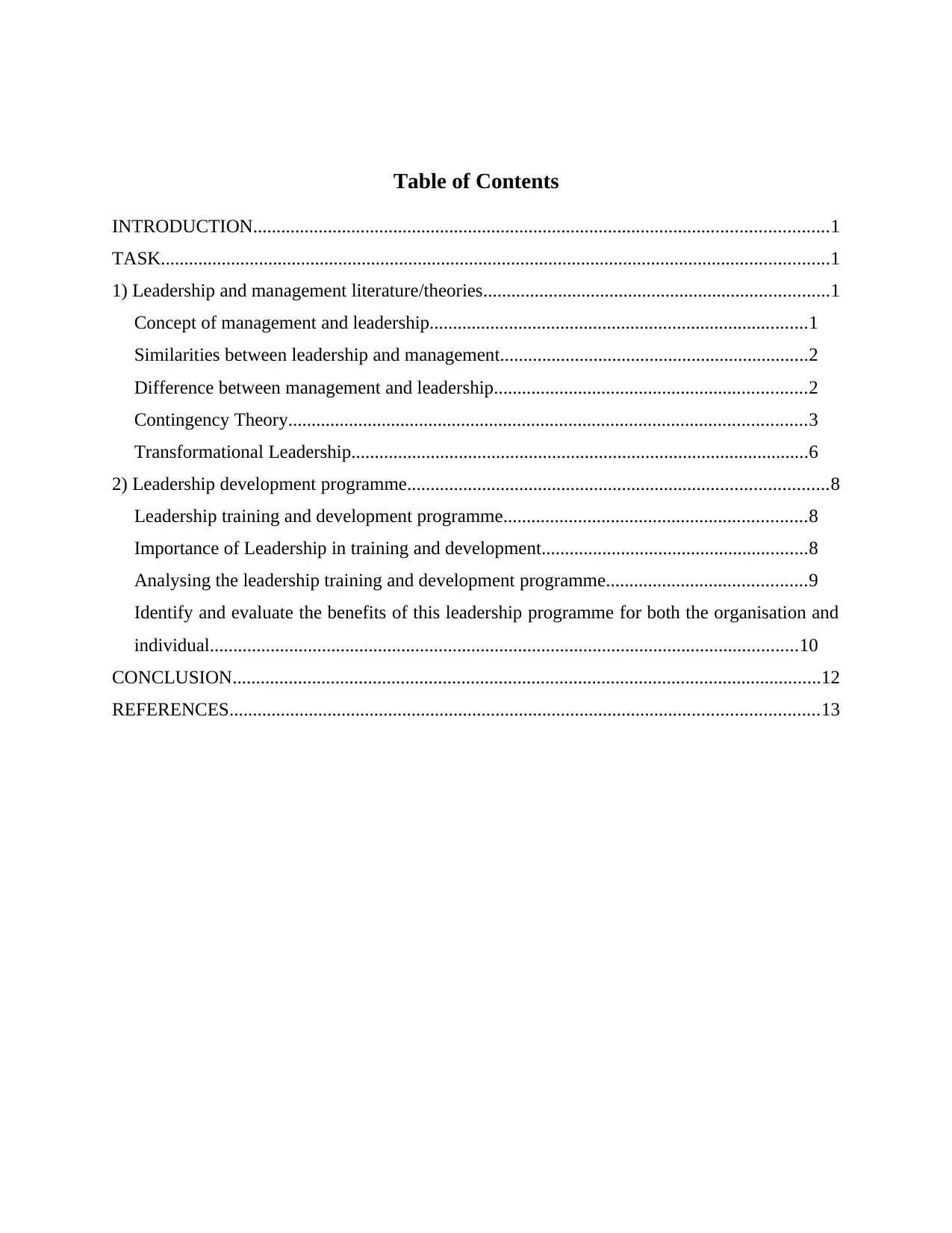
Table of Contents
INTRODUCTION...........................................................................................................................1
TASK...............................................................................................................................................1
1) Leadership and management literature/theories..........................................................................1
Concept of management and leadership.................................................................................1
Similarities between leadership and management..................................................................2
Difference between management and leadership...................................................................2
Contingency Theory...............................................................................................................3
Transformational Leadership..................................................................................................6
2) Leadership development programme..........................................................................................8
Leadership training and development programme.................................................................8
Importance of Leadership in training and development.........................................................8
Analysing the leadership training and development programme...........................................9
Identify and evaluate the benefits of this leadership programme for both the organisation and
individual..............................................................................................................................10
CONCLUSION..............................................................................................................................12
REFERENCES..............................................................................................................................13
INTRODUCTION...........................................................................................................................1
TASK...............................................................................................................................................1
1) Leadership and management literature/theories..........................................................................1
Concept of management and leadership.................................................................................1
Similarities between leadership and management..................................................................2
Difference between management and leadership...................................................................2
Contingency Theory...............................................................................................................3
Transformational Leadership..................................................................................................6
2) Leadership development programme..........................................................................................8
Leadership training and development programme.................................................................8
Importance of Leadership in training and development.........................................................8
Analysing the leadership training and development programme...........................................9
Identify and evaluate the benefits of this leadership programme for both the organisation and
individual..............................................................................................................................10
CONCLUSION..............................................................................................................................12
REFERENCES..............................................................................................................................13
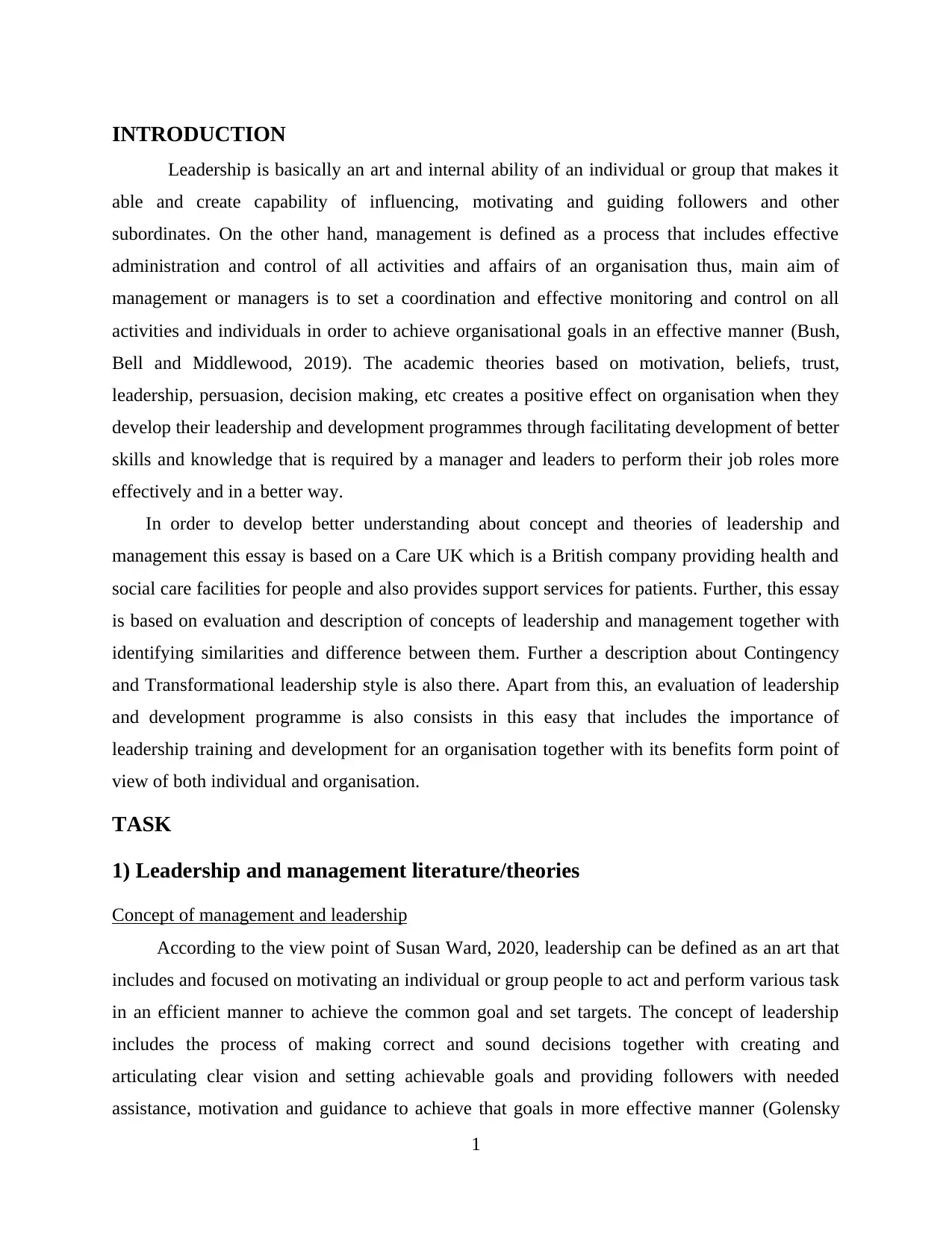
INTRODUCTION
Leadership is basically an art and internal ability of an individual or group that makes it
able and create capability of influencing, motivating and guiding followers and other
subordinates. On the other hand, management is defined as a process that includes effective
administration and control of all activities and affairs of an organisation thus, main aim of
management or managers is to set a coordination and effective monitoring and control on all
activities and individuals in order to achieve organisational goals in an effective manner (Bush,
Bell and Middlewood, 2019). The academic theories based on motivation, beliefs, trust,
leadership, persuasion, decision making, etc creates a positive effect on organisation when they
develop their leadership and development programmes through facilitating development of better
skills and knowledge that is required by a manager and leaders to perform their job roles more
effectively and in a better way.
In order to develop better understanding about concept and theories of leadership and
management this essay is based on a Care UK which is a British company providing health and
social care facilities for people and also provides support services for patients. Further, this essay
is based on evaluation and description of concepts of leadership and management together with
identifying similarities and difference between them. Further a description about Contingency
and Transformational leadership style is also there. Apart from this, an evaluation of leadership
and development programme is also consists in this easy that includes the importance of
leadership training and development for an organisation together with its benefits form point of
view of both individual and organisation.
TASK
1) Leadership and management literature/theories
Concept of management and leadership
According to the view point of Susan Ward, 2020, leadership can be defined as an art that
includes and focused on motivating an individual or group people to act and perform various task
in an efficient manner to achieve the common goal and set targets. The concept of leadership
includes the process of making correct and sound decisions together with creating and
articulating clear vision and setting achievable goals and providing followers with needed
assistance, motivation and guidance to achieve that goals in more effective manner (Golensky
1
Leadership is basically an art and internal ability of an individual or group that makes it
able and create capability of influencing, motivating and guiding followers and other
subordinates. On the other hand, management is defined as a process that includes effective
administration and control of all activities and affairs of an organisation thus, main aim of
management or managers is to set a coordination and effective monitoring and control on all
activities and individuals in order to achieve organisational goals in an effective manner (Bush,
Bell and Middlewood, 2019). The academic theories based on motivation, beliefs, trust,
leadership, persuasion, decision making, etc creates a positive effect on organisation when they
develop their leadership and development programmes through facilitating development of better
skills and knowledge that is required by a manager and leaders to perform their job roles more
effectively and in a better way.
In order to develop better understanding about concept and theories of leadership and
management this essay is based on a Care UK which is a British company providing health and
social care facilities for people and also provides support services for patients. Further, this essay
is based on evaluation and description of concepts of leadership and management together with
identifying similarities and difference between them. Further a description about Contingency
and Transformational leadership style is also there. Apart from this, an evaluation of leadership
and development programme is also consists in this easy that includes the importance of
leadership training and development for an organisation together with its benefits form point of
view of both individual and organisation.
TASK
1) Leadership and management literature/theories
Concept of management and leadership
According to the view point of Susan Ward, 2020, leadership can be defined as an art that
includes and focused on motivating an individual or group people to act and perform various task
in an efficient manner to achieve the common goal and set targets. The concept of leadership
includes the process of making correct and sound decisions together with creating and
articulating clear vision and setting achievable goals and providing followers with needed
assistance, motivation and guidance to achieve that goals in more effective manner (Golensky
1
⊘ This is a preview!⊘
Do you want full access?
Subscribe today to unlock all pages.

Trusted by 1+ million students worldwide
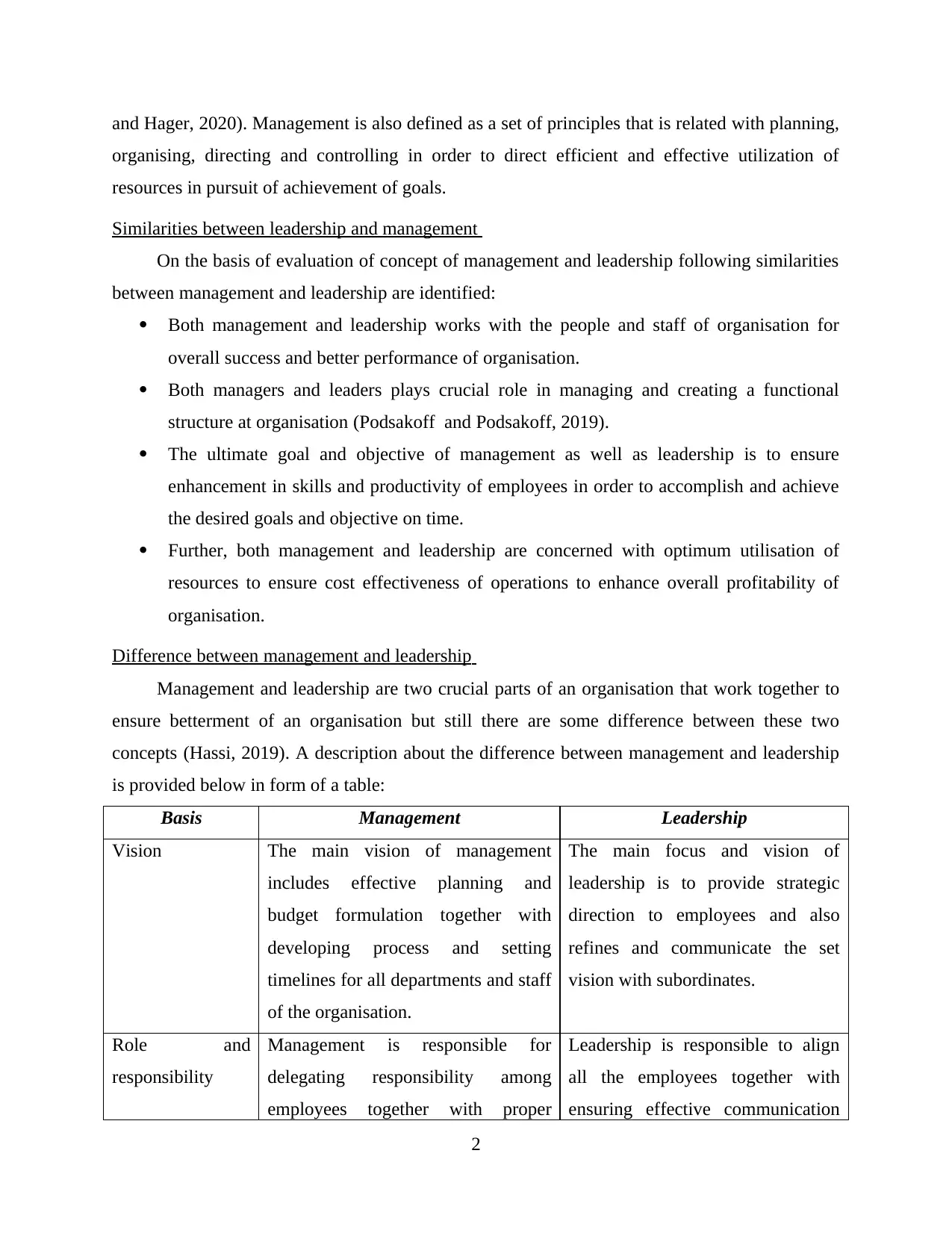
and Hager, 2020). Management is also defined as a set of principles that is related with planning,
organising, directing and controlling in order to direct efficient and effective utilization of
resources in pursuit of achievement of goals.
Similarities between leadership and management
On the basis of evaluation of concept of management and leadership following similarities
between management and leadership are identified:
Both management and leadership works with the people and staff of organisation for
overall success and better performance of organisation.
Both managers and leaders plays crucial role in managing and creating a functional
structure at organisation (Podsakoff and Podsakoff, 2019).
The ultimate goal and objective of management as well as leadership is to ensure
enhancement in skills and productivity of employees in order to accomplish and achieve
the desired goals and objective on time.
Further, both management and leadership are concerned with optimum utilisation of
resources to ensure cost effectiveness of operations to enhance overall profitability of
organisation.
Difference between management and leadership
Management and leadership are two crucial parts of an organisation that work together to
ensure betterment of an organisation but still there are some difference between these two
concepts (Hassi, 2019). A description about the difference between management and leadership
is provided below in form of a table:
Basis Management Leadership
Vision The main vision of management
includes effective planning and
budget formulation together with
developing process and setting
timelines for all departments and staff
of the organisation.
The main focus and vision of
leadership is to provide strategic
direction to employees and also
refines and communicate the set
vision with subordinates.
Role and
responsibility
Management is responsible for
delegating responsibility among
employees together with proper
Leadership is responsible to align
all the employees together with
ensuring effective communication
2
organising, directing and controlling in order to direct efficient and effective utilization of
resources in pursuit of achievement of goals.
Similarities between leadership and management
On the basis of evaluation of concept of management and leadership following similarities
between management and leadership are identified:
Both management and leadership works with the people and staff of organisation for
overall success and better performance of organisation.
Both managers and leaders plays crucial role in managing and creating a functional
structure at organisation (Podsakoff and Podsakoff, 2019).
The ultimate goal and objective of management as well as leadership is to ensure
enhancement in skills and productivity of employees in order to accomplish and achieve
the desired goals and objective on time.
Further, both management and leadership are concerned with optimum utilisation of
resources to ensure cost effectiveness of operations to enhance overall profitability of
organisation.
Difference between management and leadership
Management and leadership are two crucial parts of an organisation that work together to
ensure betterment of an organisation but still there are some difference between these two
concepts (Hassi, 2019). A description about the difference between management and leadership
is provided below in form of a table:
Basis Management Leadership
Vision The main vision of management
includes effective planning and
budget formulation together with
developing process and setting
timelines for all departments and staff
of the organisation.
The main focus and vision of
leadership is to provide strategic
direction to employees and also
refines and communicate the set
vision with subordinates.
Role and
responsibility
Management is responsible for
delegating responsibility among
employees together with proper
Leadership is responsible to align
all the employees together with
ensuring effective communication
2
Paraphrase This Document
Need a fresh take? Get an instant paraphrase of this document with our AI Paraphraser
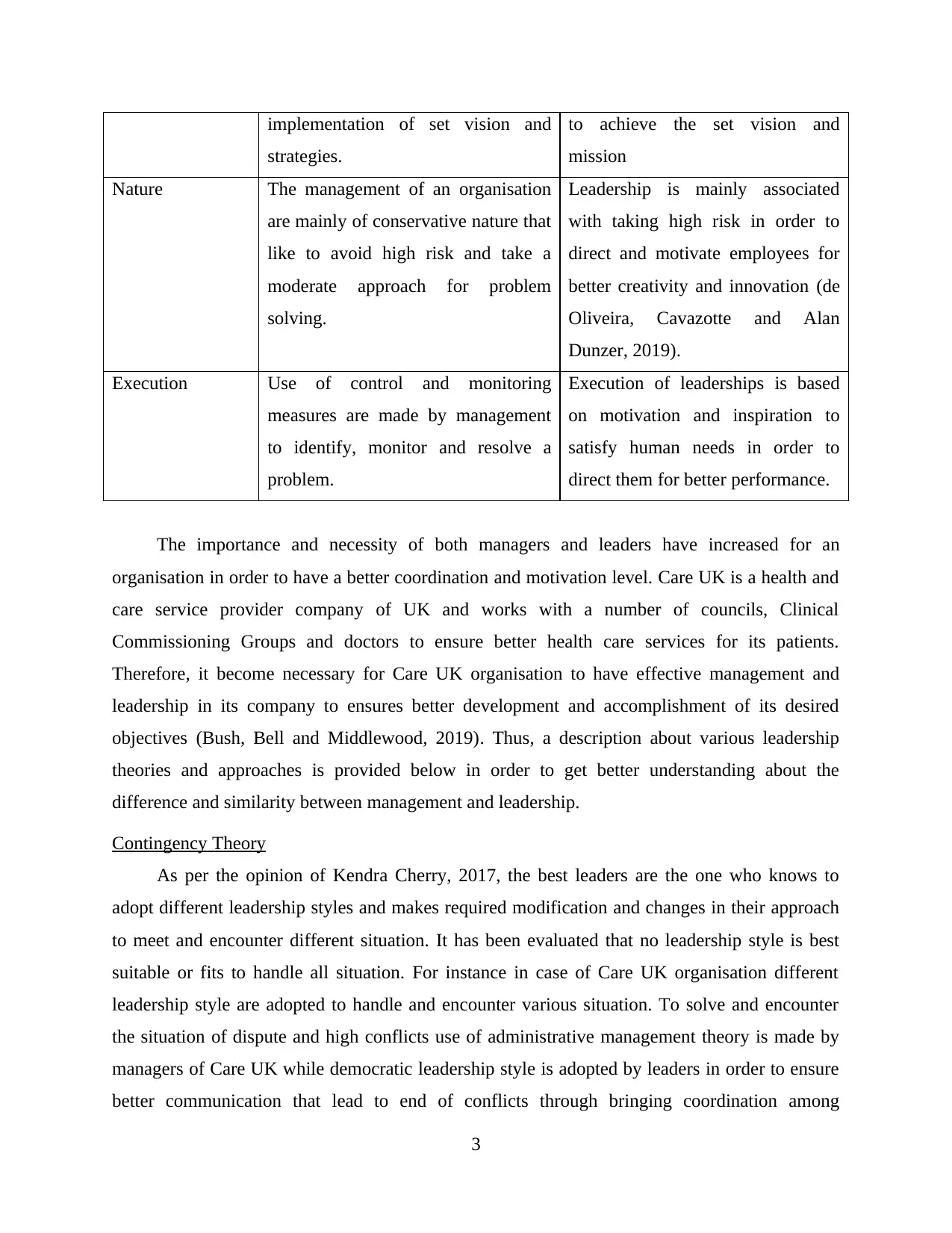
implementation of set vision and
strategies.
to achieve the set vision and
mission
Nature The management of an organisation
are mainly of conservative nature that
like to avoid high risk and take a
moderate approach for problem
solving.
Leadership is mainly associated
with taking high risk in order to
direct and motivate employees for
better creativity and innovation (de
Oliveira, Cavazotte and Alan
Dunzer, 2019).
Execution Use of control and monitoring
measures are made by management
to identify, monitor and resolve a
problem.
Execution of leaderships is based
on motivation and inspiration to
satisfy human needs in order to
direct them for better performance.
The importance and necessity of both managers and leaders have increased for an
organisation in order to have a better coordination and motivation level. Care UK is a health and
care service provider company of UK and works with a number of councils, Clinical
Commissioning Groups and doctors to ensure better health care services for its patients.
Therefore, it become necessary for Care UK organisation to have effective management and
leadership in its company to ensures better development and accomplishment of its desired
objectives (Bush, Bell and Middlewood, 2019). Thus, a description about various leadership
theories and approaches is provided below in order to get better understanding about the
difference and similarity between management and leadership.
Contingency Theory
As per the opinion of Kendra Cherry, 2017, the best leaders are the one who knows to
adopt different leadership styles and makes required modification and changes in their approach
to meet and encounter different situation. It has been evaluated that no leadership style is best
suitable or fits to handle all situation. For instance in case of Care UK organisation different
leadership style are adopted to handle and encounter various situation. To solve and encounter
the situation of dispute and high conflicts use of administrative management theory is made by
managers of Care UK while democratic leadership style is adopted by leaders in order to ensure
better communication that lead to end of conflicts through bringing coordination among
3
strategies.
to achieve the set vision and
mission
Nature The management of an organisation
are mainly of conservative nature that
like to avoid high risk and take a
moderate approach for problem
solving.
Leadership is mainly associated
with taking high risk in order to
direct and motivate employees for
better creativity and innovation (de
Oliveira, Cavazotte and Alan
Dunzer, 2019).
Execution Use of control and monitoring
measures are made by management
to identify, monitor and resolve a
problem.
Execution of leaderships is based
on motivation and inspiration to
satisfy human needs in order to
direct them for better performance.
The importance and necessity of both managers and leaders have increased for an
organisation in order to have a better coordination and motivation level. Care UK is a health and
care service provider company of UK and works with a number of councils, Clinical
Commissioning Groups and doctors to ensure better health care services for its patients.
Therefore, it become necessary for Care UK organisation to have effective management and
leadership in its company to ensures better development and accomplishment of its desired
objectives (Bush, Bell and Middlewood, 2019). Thus, a description about various leadership
theories and approaches is provided below in order to get better understanding about the
difference and similarity between management and leadership.
Contingency Theory
As per the opinion of Kendra Cherry, 2017, the best leaders are the one who knows to
adopt different leadership styles and makes required modification and changes in their approach
to meet and encounter different situation. It has been evaluated that no leadership style is best
suitable or fits to handle all situation. For instance in case of Care UK organisation different
leadership style are adopted to handle and encounter various situation. To solve and encounter
the situation of dispute and high conflicts use of administrative management theory is made by
managers of Care UK while democratic leadership style is adopted by leaders in order to ensure
better communication that lead to end of conflicts through bringing coordination among
3
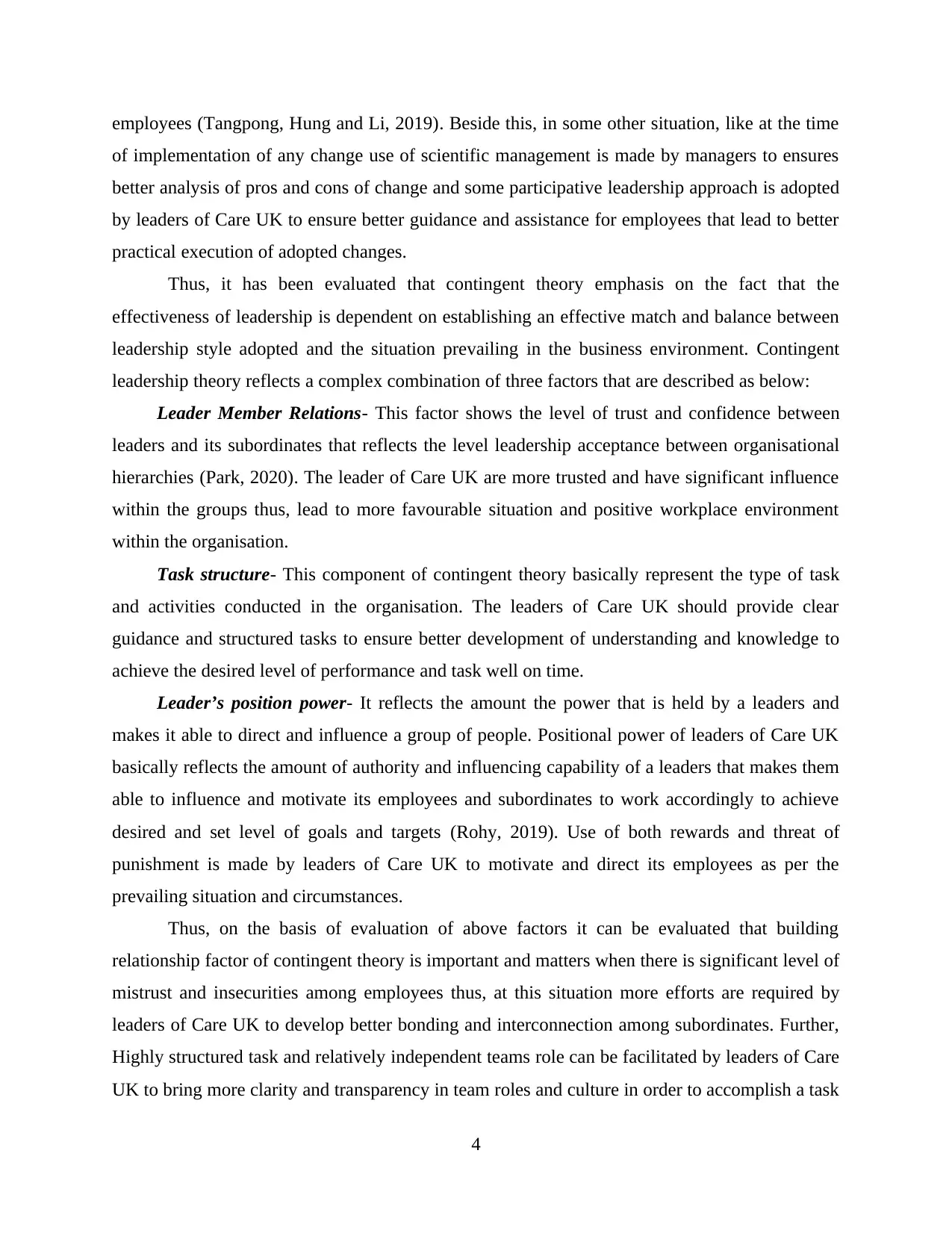
employees (Tangpong, Hung and Li, 2019). Beside this, in some other situation, like at the time
of implementation of any change use of scientific management is made by managers to ensures
better analysis of pros and cons of change and some participative leadership approach is adopted
by leaders of Care UK to ensure better guidance and assistance for employees that lead to better
practical execution of adopted changes.
Thus, it has been evaluated that contingent theory emphasis on the fact that the
effectiveness of leadership is dependent on establishing an effective match and balance between
leadership style adopted and the situation prevailing in the business environment. Contingent
leadership theory reflects a complex combination of three factors that are described as below:
Leader Member Relations- This factor shows the level of trust and confidence between
leaders and its subordinates that reflects the level leadership acceptance between organisational
hierarchies (Park, 2020). The leader of Care UK are more trusted and have significant influence
within the groups thus, lead to more favourable situation and positive workplace environment
within the organisation.
Task structure- This component of contingent theory basically represent the type of task
and activities conducted in the organisation. The leaders of Care UK should provide clear
guidance and structured tasks to ensure better development of understanding and knowledge to
achieve the desired level of performance and task well on time.
Leader’s position power- It reflects the amount the power that is held by a leaders and
makes it able to direct and influence a group of people. Positional power of leaders of Care UK
basically reflects the amount of authority and influencing capability of a leaders that makes them
able to influence and motivate its employees and subordinates to work accordingly to achieve
desired and set level of goals and targets (Rohy, 2019). Use of both rewards and threat of
punishment is made by leaders of Care UK to motivate and direct its employees as per the
prevailing situation and circumstances.
Thus, on the basis of evaluation of above factors it can be evaluated that building
relationship factor of contingent theory is important and matters when there is significant level of
mistrust and insecurities among employees thus, at this situation more efforts are required by
leaders of Care UK to develop better bonding and interconnection among subordinates. Further,
Highly structured task and relatively independent teams role can be facilitated by leaders of Care
UK to bring more clarity and transparency in team roles and culture in order to accomplish a task
4
of implementation of any change use of scientific management is made by managers to ensures
better analysis of pros and cons of change and some participative leadership approach is adopted
by leaders of Care UK to ensure better guidance and assistance for employees that lead to better
practical execution of adopted changes.
Thus, it has been evaluated that contingent theory emphasis on the fact that the
effectiveness of leadership is dependent on establishing an effective match and balance between
leadership style adopted and the situation prevailing in the business environment. Contingent
leadership theory reflects a complex combination of three factors that are described as below:
Leader Member Relations- This factor shows the level of trust and confidence between
leaders and its subordinates that reflects the level leadership acceptance between organisational
hierarchies (Park, 2020). The leader of Care UK are more trusted and have significant influence
within the groups thus, lead to more favourable situation and positive workplace environment
within the organisation.
Task structure- This component of contingent theory basically represent the type of task
and activities conducted in the organisation. The leaders of Care UK should provide clear
guidance and structured tasks to ensure better development of understanding and knowledge to
achieve the desired level of performance and task well on time.
Leader’s position power- It reflects the amount the power that is held by a leaders and
makes it able to direct and influence a group of people. Positional power of leaders of Care UK
basically reflects the amount of authority and influencing capability of a leaders that makes them
able to influence and motivate its employees and subordinates to work accordingly to achieve
desired and set level of goals and targets (Rohy, 2019). Use of both rewards and threat of
punishment is made by leaders of Care UK to motivate and direct its employees as per the
prevailing situation and circumstances.
Thus, on the basis of evaluation of above factors it can be evaluated that building
relationship factor of contingent theory is important and matters when there is significant level of
mistrust and insecurities among employees thus, at this situation more efforts are required by
leaders of Care UK to develop better bonding and interconnection among subordinates. Further,
Highly structured task and relatively independent teams role can be facilitated by leaders of Care
UK to bring more clarity and transparency in team roles and culture in order to accomplish a task
4
⊘ This is a preview!⊘
Do you want full access?
Subscribe today to unlock all pages.

Trusted by 1+ million students worldwide
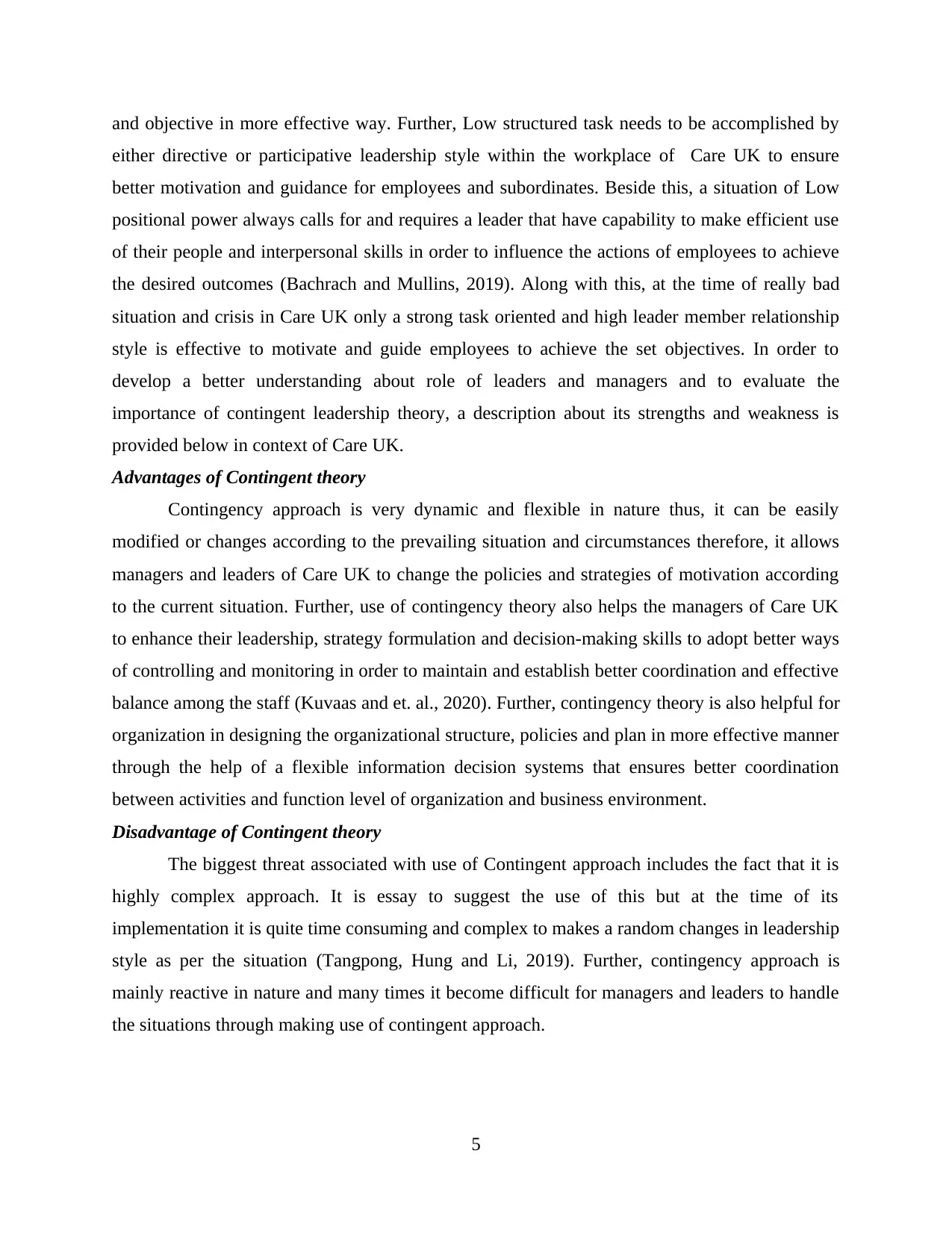
and objective in more effective way. Further, Low structured task needs to be accomplished by
either directive or participative leadership style within the workplace of Care UK to ensure
better motivation and guidance for employees and subordinates. Beside this, a situation of Low
positional power always calls for and requires a leader that have capability to make efficient use
of their people and interpersonal skills in order to influence the actions of employees to achieve
the desired outcomes (Bachrach and Mullins, 2019). Along with this, at the time of really bad
situation and crisis in Care UK only a strong task oriented and high leader member relationship
style is effective to motivate and guide employees to achieve the set objectives. In order to
develop a better understanding about role of leaders and managers and to evaluate the
importance of contingent leadership theory, a description about its strengths and weakness is
provided below in context of Care UK.
Advantages of Contingent theory
Contingency approach is very dynamic and flexible in nature thus, it can be easily
modified or changes according to the prevailing situation and circumstances therefore, it allows
managers and leaders of Care UK to change the policies and strategies of motivation according
to the current situation. Further, use of contingency theory also helps the managers of Care UK
to enhance their leadership, strategy formulation and decision-making skills to adopt better ways
of controlling and monitoring in order to maintain and establish better coordination and effective
balance among the staff (Kuvaas and et. al., 2020). Further, contingency theory is also helpful for
organization in designing the organizational structure, policies and plan in more effective manner
through the help of a flexible information decision systems that ensures better coordination
between activities and function level of organization and business environment.
Disadvantage of Contingent theory
The biggest threat associated with use of Contingent approach includes the fact that it is
highly complex approach. It is essay to suggest the use of this but at the time of its
implementation it is quite time consuming and complex to makes a random changes in leadership
style as per the situation (Tangpong, Hung and Li, 2019). Further, contingency approach is
mainly reactive in nature and many times it become difficult for managers and leaders to handle
the situations through making use of contingent approach.
5
either directive or participative leadership style within the workplace of Care UK to ensure
better motivation and guidance for employees and subordinates. Beside this, a situation of Low
positional power always calls for and requires a leader that have capability to make efficient use
of their people and interpersonal skills in order to influence the actions of employees to achieve
the desired outcomes (Bachrach and Mullins, 2019). Along with this, at the time of really bad
situation and crisis in Care UK only a strong task oriented and high leader member relationship
style is effective to motivate and guide employees to achieve the set objectives. In order to
develop a better understanding about role of leaders and managers and to evaluate the
importance of contingent leadership theory, a description about its strengths and weakness is
provided below in context of Care UK.
Advantages of Contingent theory
Contingency approach is very dynamic and flexible in nature thus, it can be easily
modified or changes according to the prevailing situation and circumstances therefore, it allows
managers and leaders of Care UK to change the policies and strategies of motivation according
to the current situation. Further, use of contingency theory also helps the managers of Care UK
to enhance their leadership, strategy formulation and decision-making skills to adopt better ways
of controlling and monitoring in order to maintain and establish better coordination and effective
balance among the staff (Kuvaas and et. al., 2020). Further, contingency theory is also helpful for
organization in designing the organizational structure, policies and plan in more effective manner
through the help of a flexible information decision systems that ensures better coordination
between activities and function level of organization and business environment.
Disadvantage of Contingent theory
The biggest threat associated with use of Contingent approach includes the fact that it is
highly complex approach. It is essay to suggest the use of this but at the time of its
implementation it is quite time consuming and complex to makes a random changes in leadership
style as per the situation (Tangpong, Hung and Li, 2019). Further, contingency approach is
mainly reactive in nature and many times it become difficult for managers and leaders to handle
the situations through making use of contingent approach.
5
Paraphrase This Document
Need a fresh take? Get an instant paraphrase of this document with our AI Paraphraser
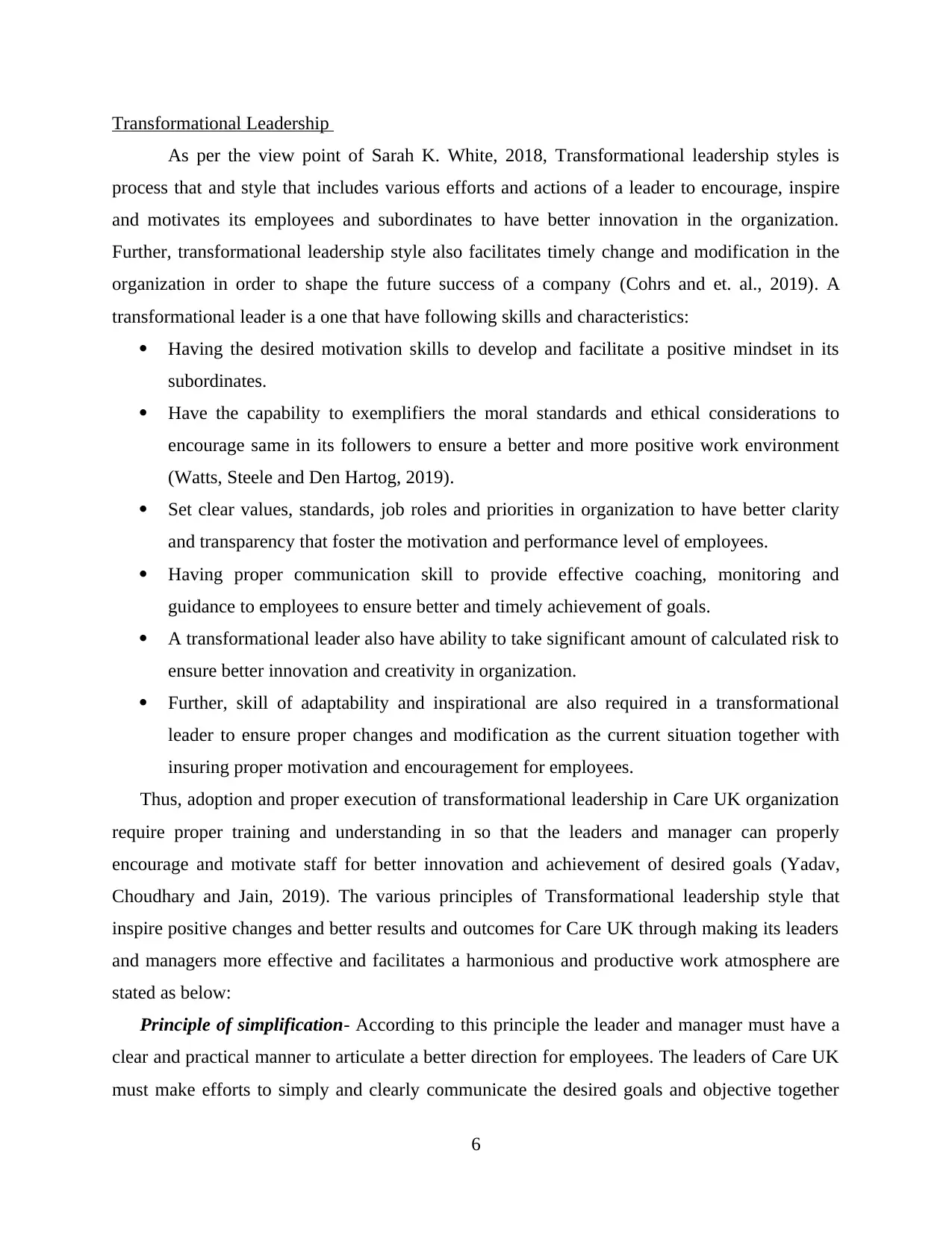
Transformational Leadership
As per the view point of Sarah K. White, 2018, Transformational leadership styles is
process that and style that includes various efforts and actions of a leader to encourage, inspire
and motivates its employees and subordinates to have better innovation in the organization.
Further, transformational leadership style also facilitates timely change and modification in the
organization in order to shape the future success of a company (Cohrs and et. al., 2019). A
transformational leader is a one that have following skills and characteristics:
Having the desired motivation skills to develop and facilitate a positive mindset in its
subordinates.
Have the capability to exemplifiers the moral standards and ethical considerations to
encourage same in its followers to ensure a better and more positive work environment
(Watts, Steele and Den Hartog, 2019).
Set clear values, standards, job roles and priorities in organization to have better clarity
and transparency that foster the motivation and performance level of employees.
Having proper communication skill to provide effective coaching, monitoring and
guidance to employees to ensure better and timely achievement of goals.
A transformational leader also have ability to take significant amount of calculated risk to
ensure better innovation and creativity in organization.
Further, skill of adaptability and inspirational are also required in a transformational
leader to ensure proper changes and modification as the current situation together with
insuring proper motivation and encouragement for employees.
Thus, adoption and proper execution of transformational leadership in Care UK organization
require proper training and understanding in so that the leaders and manager can properly
encourage and motivate staff for better innovation and achievement of desired goals (Yadav,
Choudhary and Jain, 2019). The various principles of Transformational leadership style that
inspire positive changes and better results and outcomes for Care UK through making its leaders
and managers more effective and facilitates a harmonious and productive work atmosphere are
stated as below:
Principle of simplification- According to this principle the leader and manager must have a
clear and practical manner to articulate a better direction for employees. The leaders of Care UK
must make efforts to simply and clearly communicate the desired goals and objective together
6
As per the view point of Sarah K. White, 2018, Transformational leadership styles is
process that and style that includes various efforts and actions of a leader to encourage, inspire
and motivates its employees and subordinates to have better innovation in the organization.
Further, transformational leadership style also facilitates timely change and modification in the
organization in order to shape the future success of a company (Cohrs and et. al., 2019). A
transformational leader is a one that have following skills and characteristics:
Having the desired motivation skills to develop and facilitate a positive mindset in its
subordinates.
Have the capability to exemplifiers the moral standards and ethical considerations to
encourage same in its followers to ensure a better and more positive work environment
(Watts, Steele and Den Hartog, 2019).
Set clear values, standards, job roles and priorities in organization to have better clarity
and transparency that foster the motivation and performance level of employees.
Having proper communication skill to provide effective coaching, monitoring and
guidance to employees to ensure better and timely achievement of goals.
A transformational leader also have ability to take significant amount of calculated risk to
ensure better innovation and creativity in organization.
Further, skill of adaptability and inspirational are also required in a transformational
leader to ensure proper changes and modification as the current situation together with
insuring proper motivation and encouragement for employees.
Thus, adoption and proper execution of transformational leadership in Care UK organization
require proper training and understanding in so that the leaders and manager can properly
encourage and motivate staff for better innovation and achievement of desired goals (Yadav,
Choudhary and Jain, 2019). The various principles of Transformational leadership style that
inspire positive changes and better results and outcomes for Care UK through making its leaders
and managers more effective and facilitates a harmonious and productive work atmosphere are
stated as below:
Principle of simplification- According to this principle the leader and manager must have a
clear and practical manner to articulate a better direction for employees. The leaders of Care UK
must make efforts to simply and clearly communicate the desired goals and objective together
6
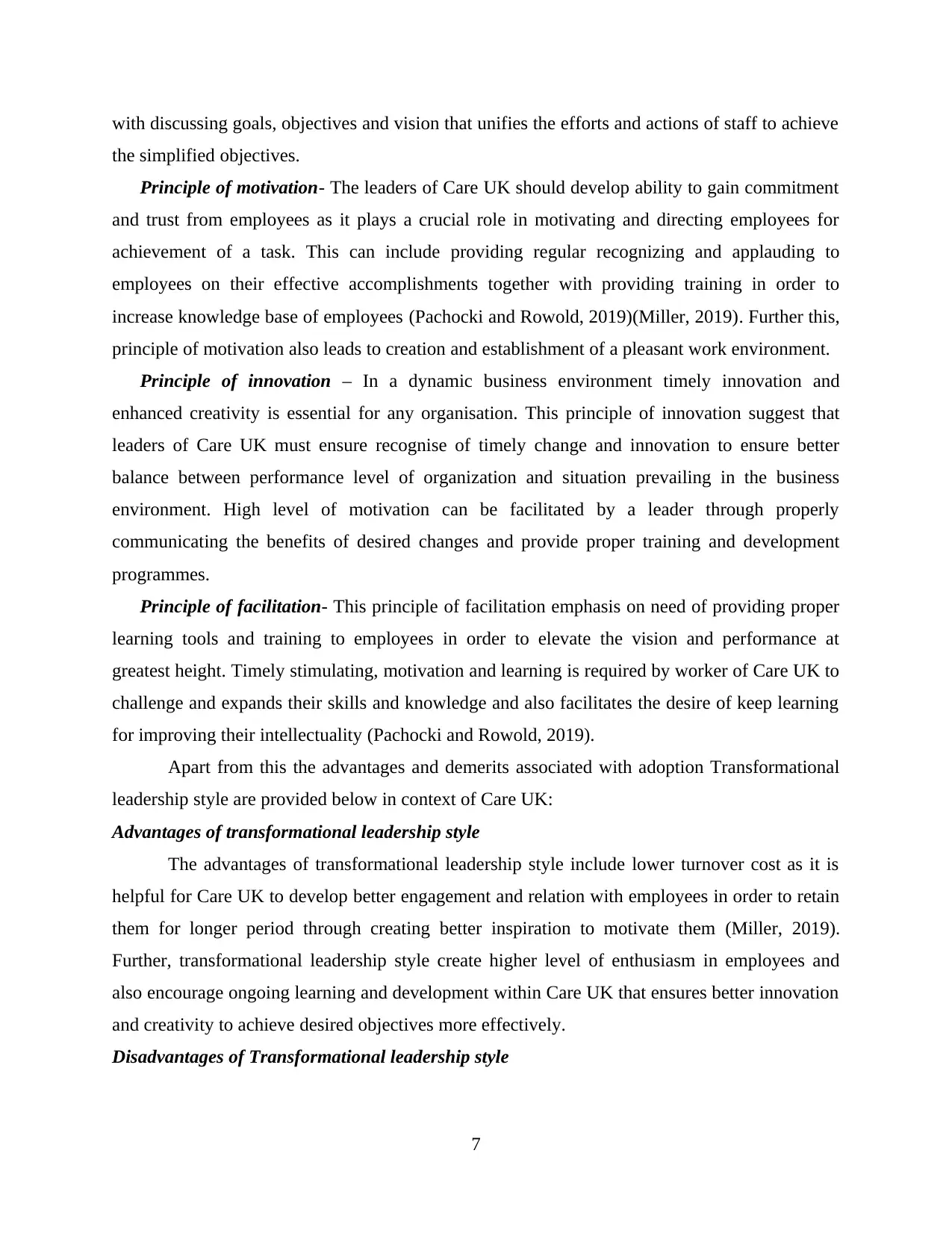
with discussing goals, objectives and vision that unifies the efforts and actions of staff to achieve
the simplified objectives.
Principle of motivation- The leaders of Care UK should develop ability to gain commitment
and trust from employees as it plays a crucial role in motivating and directing employees for
achievement of a task. This can include providing regular recognizing and applauding to
employees on their effective accomplishments together with providing training in order to
increase knowledge base of employees (Pachocki and Rowold, 2019)(Miller, 2019). Further this,
principle of motivation also leads to creation and establishment of a pleasant work environment.
Principle of innovation – In a dynamic business environment timely innovation and
enhanced creativity is essential for any organisation. This principle of innovation suggest that
leaders of Care UK must ensure recognise of timely change and innovation to ensure better
balance between performance level of organization and situation prevailing in the business
environment. High level of motivation can be facilitated by a leader through properly
communicating the benefits of desired changes and provide proper training and development
programmes.
Principle of facilitation- This principle of facilitation emphasis on need of providing proper
learning tools and training to employees in order to elevate the vision and performance at
greatest height. Timely stimulating, motivation and learning is required by worker of Care UK to
challenge and expands their skills and knowledge and also facilitates the desire of keep learning
for improving their intellectuality (Pachocki and Rowold, 2019).
Apart from this the advantages and demerits associated with adoption Transformational
leadership style are provided below in context of Care UK:
Advantages of transformational leadership style
The advantages of transformational leadership style include lower turnover cost as it is
helpful for Care UK to develop better engagement and relation with employees in order to retain
them for longer period through creating better inspiration to motivate them (Miller, 2019).
Further, transformational leadership style create higher level of enthusiasm in employees and
also encourage ongoing learning and development within Care UK that ensures better innovation
and creativity to achieve desired objectives more effectively.
Disadvantages of Transformational leadership style
7
the simplified objectives.
Principle of motivation- The leaders of Care UK should develop ability to gain commitment
and trust from employees as it plays a crucial role in motivating and directing employees for
achievement of a task. This can include providing regular recognizing and applauding to
employees on their effective accomplishments together with providing training in order to
increase knowledge base of employees (Pachocki and Rowold, 2019)(Miller, 2019). Further this,
principle of motivation also leads to creation and establishment of a pleasant work environment.
Principle of innovation – In a dynamic business environment timely innovation and
enhanced creativity is essential for any organisation. This principle of innovation suggest that
leaders of Care UK must ensure recognise of timely change and innovation to ensure better
balance between performance level of organization and situation prevailing in the business
environment. High level of motivation can be facilitated by a leader through properly
communicating the benefits of desired changes and provide proper training and development
programmes.
Principle of facilitation- This principle of facilitation emphasis on need of providing proper
learning tools and training to employees in order to elevate the vision and performance at
greatest height. Timely stimulating, motivation and learning is required by worker of Care UK to
challenge and expands their skills and knowledge and also facilitates the desire of keep learning
for improving their intellectuality (Pachocki and Rowold, 2019).
Apart from this the advantages and demerits associated with adoption Transformational
leadership style are provided below in context of Care UK:
Advantages of transformational leadership style
The advantages of transformational leadership style include lower turnover cost as it is
helpful for Care UK to develop better engagement and relation with employees in order to retain
them for longer period through creating better inspiration to motivate them (Miller, 2019).
Further, transformational leadership style create higher level of enthusiasm in employees and
also encourage ongoing learning and development within Care UK that ensures better innovation
and creativity to achieve desired objectives more effectively.
Disadvantages of Transformational leadership style
7
⊘ This is a preview!⊘
Do you want full access?
Subscribe today to unlock all pages.

Trusted by 1+ million students worldwide
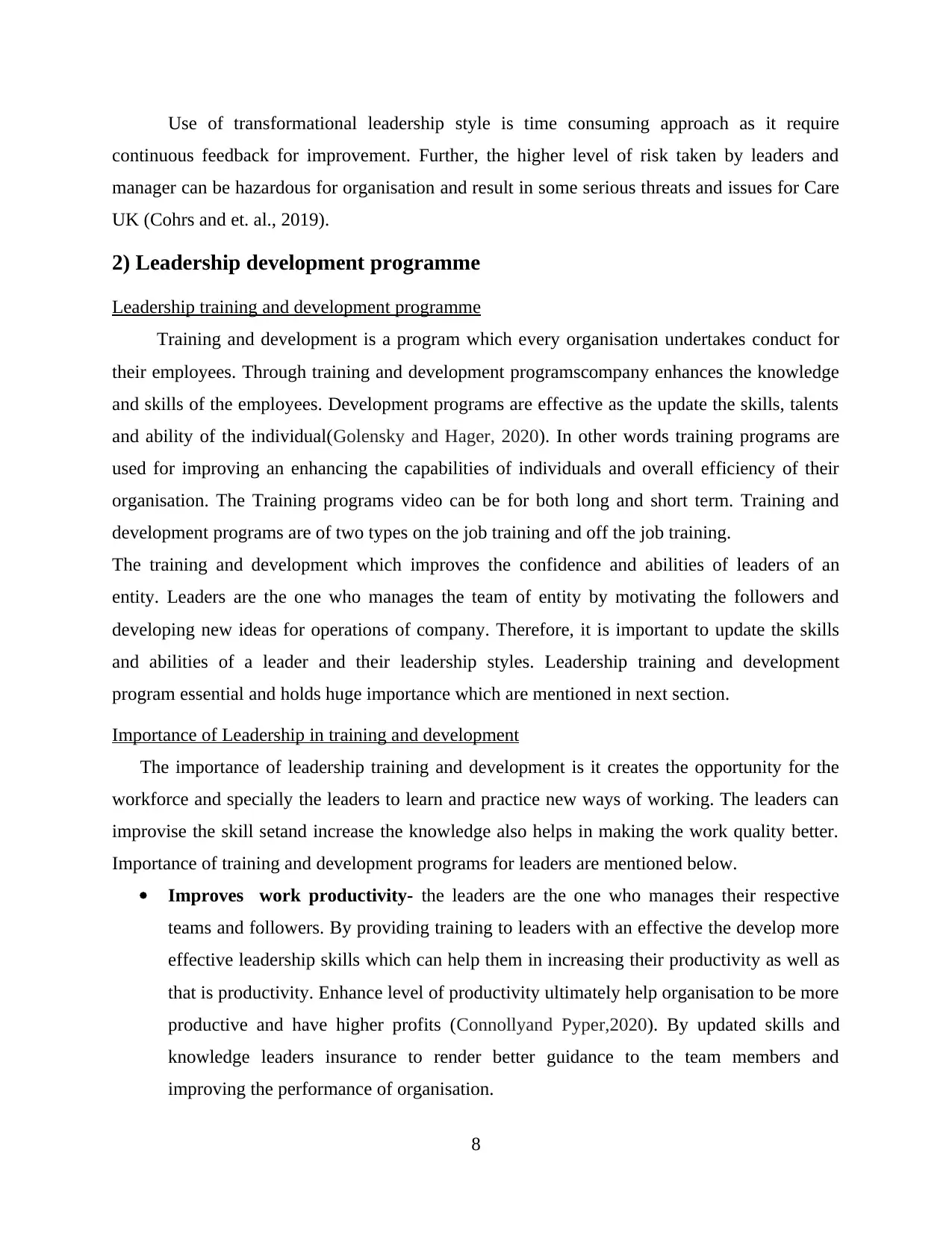
Use of transformational leadership style is time consuming approach as it require
continuous feedback for improvement. Further, the higher level of risk taken by leaders and
manager can be hazardous for organisation and result in some serious threats and issues for Care
UK (Cohrs and et. al., 2019).
2) Leadership development programme
Leadership training and development programme
Training and development is a program which every organisation undertakes conduct for
their employees. Through training and development programscompany enhances the knowledge
and skills of the employees. Development programs are effective as the update the skills, talents
and ability of the individual(Golensky and Hager, 2020). In other words training programs are
used for improving an enhancing the capabilities of individuals and overall efficiency of their
organisation. The Training programs video can be for both long and short term. Training and
development programs are of two types on the job training and off the job training.
The training and development which improves the confidence and abilities of leaders of an
entity. Leaders are the one who manages the team of entity by motivating the followers and
developing new ideas for operations of company. Therefore, it is important to update the skills
and abilities of a leader and their leadership styles. Leadership training and development
program essential and holds huge importance which are mentioned in next section.
Importance of Leadership in training and development
The importance of leadership training and development is it creates the opportunity for the
workforce and specially the leaders to learn and practice new ways of working. The leaders can
improvise the skill setand increase the knowledge also helps in making the work quality better.
Importance of training and development programs for leaders are mentioned below.
Improves work productivity- the leaders are the one who manages their respective
teams and followers. By providing training to leaders with an effective the develop more
effective leadership skills which can help them in increasing their productivity as well as
that is productivity. Enhance level of productivity ultimately help organisation to be more
productive and have higher profits (Connollyand Pyper,2020). By updated skills and
knowledge leaders insurance to render better guidance to the team members and
improving the performance of organisation.
8
continuous feedback for improvement. Further, the higher level of risk taken by leaders and
manager can be hazardous for organisation and result in some serious threats and issues for Care
UK (Cohrs and et. al., 2019).
2) Leadership development programme
Leadership training and development programme
Training and development is a program which every organisation undertakes conduct for
their employees. Through training and development programscompany enhances the knowledge
and skills of the employees. Development programs are effective as the update the skills, talents
and ability of the individual(Golensky and Hager, 2020). In other words training programs are
used for improving an enhancing the capabilities of individuals and overall efficiency of their
organisation. The Training programs video can be for both long and short term. Training and
development programs are of two types on the job training and off the job training.
The training and development which improves the confidence and abilities of leaders of an
entity. Leaders are the one who manages the team of entity by motivating the followers and
developing new ideas for operations of company. Therefore, it is important to update the skills
and abilities of a leader and their leadership styles. Leadership training and development
program essential and holds huge importance which are mentioned in next section.
Importance of Leadership in training and development
The importance of leadership training and development is it creates the opportunity for the
workforce and specially the leaders to learn and practice new ways of working. The leaders can
improvise the skill setand increase the knowledge also helps in making the work quality better.
Importance of training and development programs for leaders are mentioned below.
Improves work productivity- the leaders are the one who manages their respective
teams and followers. By providing training to leaders with an effective the develop more
effective leadership skills which can help them in increasing their productivity as well as
that is productivity. Enhance level of productivity ultimately help organisation to be more
productive and have higher profits (Connollyand Pyper,2020). By updated skills and
knowledge leaders insurance to render better guidance to the team members and
improving the performance of organisation.
8
Paraphrase This Document
Need a fresh take? Get an instant paraphrase of this document with our AI Paraphraser
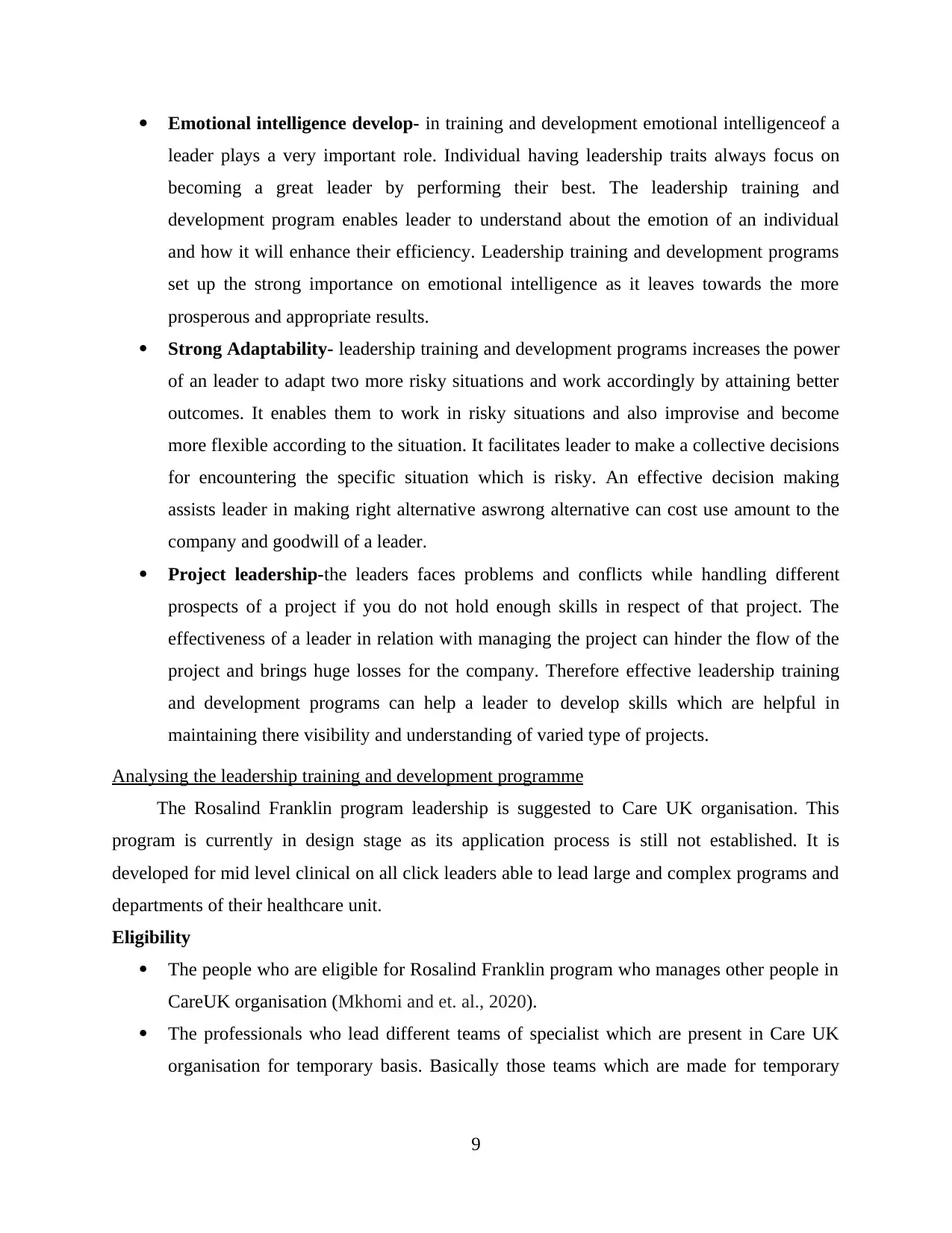
Emotional intelligence develop- in training and development emotional intelligenceof a
leader plays a very important role. Individual having leadership traits always focus on
becoming a great leader by performing their best. The leadership training and
development program enables leader to understand about the emotion of an individual
and how it will enhance their efficiency. Leadership training and development programs
set up the strong importance on emotional intelligence as it leaves towards the more
prosperous and appropriate results.
Strong Adaptability- leadership training and development programs increases the power
of an leader to adapt two more risky situations and work accordingly by attaining better
outcomes. It enables them to work in risky situations and also improvise and become
more flexible according to the situation. It facilitates leader to make a collective decisions
for encountering the specific situation which is risky. An effective decision making
assists leader in making right alternative aswrong alternative can cost use amount to the
company and goodwill of a leader.
Project leadership-the leaders faces problems and conflicts while handling different
prospects of a project if you do not hold enough skills in respect of that project. The
effectiveness of a leader in relation with managing the project can hinder the flow of the
project and brings huge losses for the company. Therefore effective leadership training
and development programs can help a leader to develop skills which are helpful in
maintaining there visibility and understanding of varied type of projects.
Analysing the leadership training and development programme
The Rosalind Franklin program leadership is suggested to Care UK organisation. This
program is currently in design stage as its application process is still not established. It is
developed for mid level clinical on all click leaders able to lead large and complex programs and
departments of their healthcare unit.
Eligibility
The people who are eligible for Rosalind Franklin program who manages other people in
CareUK organisation (Mkhomi and et. al., 2020).
The professionals who lead different teams of specialist which are present in Care UK
organisation for temporary basis. Basically those teams which are made for temporary
9
leader plays a very important role. Individual having leadership traits always focus on
becoming a great leader by performing their best. The leadership training and
development program enables leader to understand about the emotion of an individual
and how it will enhance their efficiency. Leadership training and development programs
set up the strong importance on emotional intelligence as it leaves towards the more
prosperous and appropriate results.
Strong Adaptability- leadership training and development programs increases the power
of an leader to adapt two more risky situations and work accordingly by attaining better
outcomes. It enables them to work in risky situations and also improvise and become
more flexible according to the situation. It facilitates leader to make a collective decisions
for encountering the specific situation which is risky. An effective decision making
assists leader in making right alternative aswrong alternative can cost use amount to the
company and goodwill of a leader.
Project leadership-the leaders faces problems and conflicts while handling different
prospects of a project if you do not hold enough skills in respect of that project. The
effectiveness of a leader in relation with managing the project can hinder the flow of the
project and brings huge losses for the company. Therefore effective leadership training
and development programs can help a leader to develop skills which are helpful in
maintaining there visibility and understanding of varied type of projects.
Analysing the leadership training and development programme
The Rosalind Franklin program leadership is suggested to Care UK organisation. This
program is currently in design stage as its application process is still not established. It is
developed for mid level clinical on all click leaders able to lead large and complex programs and
departments of their healthcare unit.
Eligibility
The people who are eligible for Rosalind Franklin program who manages other people in
CareUK organisation (Mkhomi and et. al., 2020).
The professionals who lead different teams of specialist which are present in Care UK
organisation for temporary basis. Basically those teams which are made for temporary
9
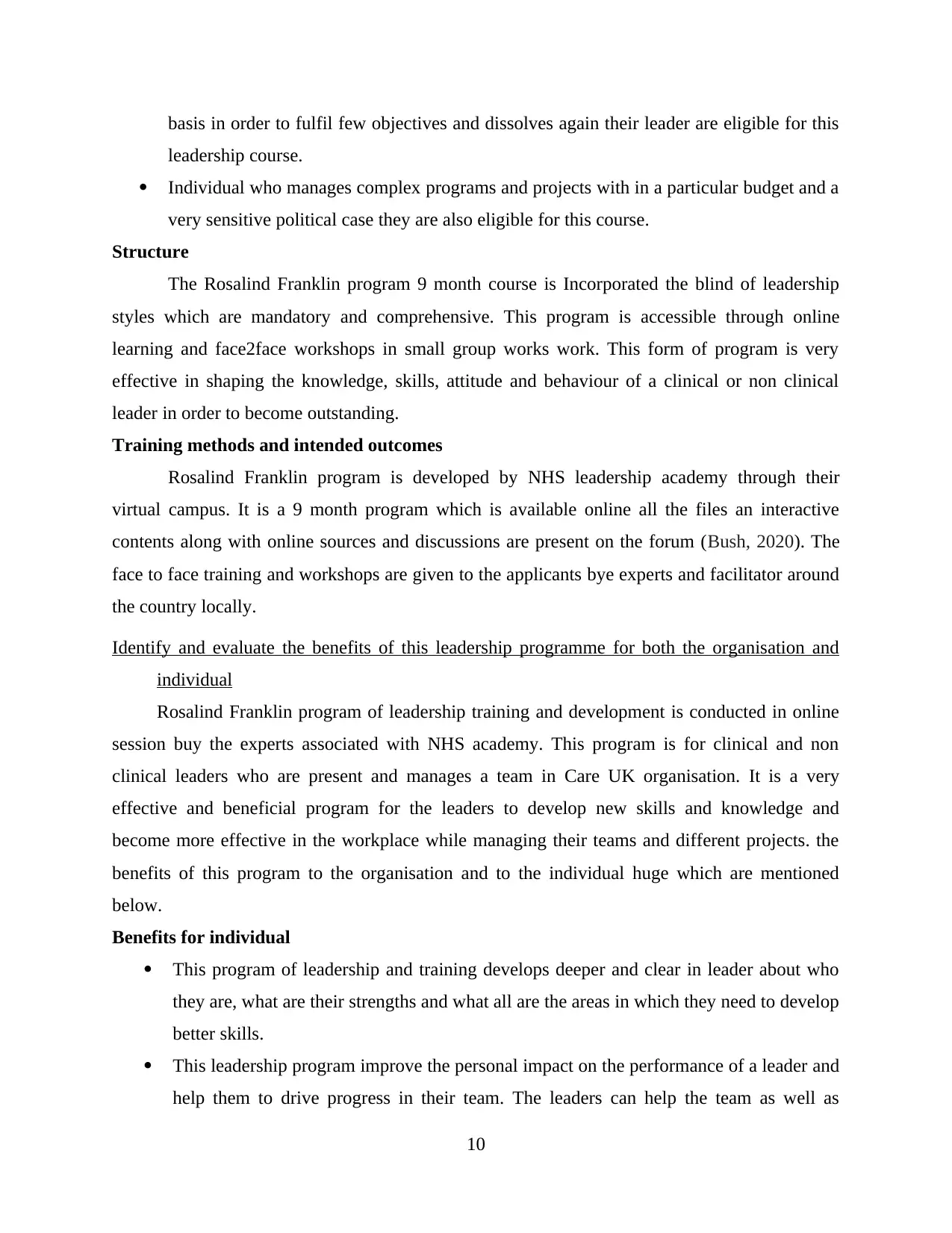
basis in order to fulfil few objectives and dissolves again their leader are eligible for this
leadership course.
Individual who manages complex programs and projects with in a particular budget and a
very sensitive political case they are also eligible for this course.
Structure
The Rosalind Franklin program 9 month course is Incorporated the blind of leadership
styles which are mandatory and comprehensive. This program is accessible through online
learning and face2face workshops in small group works work. This form of program is very
effective in shaping the knowledge, skills, attitude and behaviour of a clinical or non clinical
leader in order to become outstanding.
Training methods and intended outcomes
Rosalind Franklin program is developed by NHS leadership academy through their
virtual campus. It is a 9 month program which is available online all the files an interactive
contents along with online sources and discussions are present on the forum (Bush, 2020). The
face to face training and workshops are given to the applicants bye experts and facilitator around
the country locally.
Identify and evaluate the benefits of this leadership programme for both the organisation and
individual
Rosalind Franklin program of leadership training and development is conducted in online
session buy the experts associated with NHS academy. This program is for clinical and non
clinical leaders who are present and manages a team in Care UK organisation. It is a very
effective and beneficial program for the leaders to develop new skills and knowledge and
become more effective in the workplace while managing their teams and different projects. the
benefits of this program to the organisation and to the individual huge which are mentioned
below.
Benefits for individual
This program of leadership and training develops deeper and clear in leader about who
they are, what are their strengths and what all are the areas in which they need to develop
better skills.
This leadership program improve the personal impact on the performance of a leader and
help them to drive progress in their team. The leaders can help the team as well as
10
leadership course.
Individual who manages complex programs and projects with in a particular budget and a
very sensitive political case they are also eligible for this course.
Structure
The Rosalind Franklin program 9 month course is Incorporated the blind of leadership
styles which are mandatory and comprehensive. This program is accessible through online
learning and face2face workshops in small group works work. This form of program is very
effective in shaping the knowledge, skills, attitude and behaviour of a clinical or non clinical
leader in order to become outstanding.
Training methods and intended outcomes
Rosalind Franklin program is developed by NHS leadership academy through their
virtual campus. It is a 9 month program which is available online all the files an interactive
contents along with online sources and discussions are present on the forum (Bush, 2020). The
face to face training and workshops are given to the applicants bye experts and facilitator around
the country locally.
Identify and evaluate the benefits of this leadership programme for both the organisation and
individual
Rosalind Franklin program of leadership training and development is conducted in online
session buy the experts associated with NHS academy. This program is for clinical and non
clinical leaders who are present and manages a team in Care UK organisation. It is a very
effective and beneficial program for the leaders to develop new skills and knowledge and
become more effective in the workplace while managing their teams and different projects. the
benefits of this program to the organisation and to the individual huge which are mentioned
below.
Benefits for individual
This program of leadership and training develops deeper and clear in leader about who
they are, what are their strengths and what all are the areas in which they need to develop
better skills.
This leadership program improve the personal impact on the performance of a leader and
help them to drive progress in their team. The leaders can help the team as well as
10
⊘ This is a preview!⊘
Do you want full access?
Subscribe today to unlock all pages.

Trusted by 1+ million students worldwide
1 out of 16
Related Documents
Your All-in-One AI-Powered Toolkit for Academic Success.
+13062052269
info@desklib.com
Available 24*7 on WhatsApp / Email
![[object Object]](/_next/static/media/star-bottom.7253800d.svg)
Unlock your academic potential
Copyright © 2020–2025 A2Z Services. All Rights Reserved. Developed and managed by ZUCOL.





